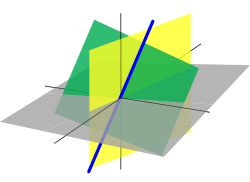
Back Lineêre algebra Afrikaans Lineare Algebra ALS Alchebra lineal AN جبر خطي Arabic Álxebra llinial AST Xətti cəbr Azerbaijani Һыҙыҡлы алгебра Bashkir Лінейная алгебра Byelorussian Лінейная альгебра BE-X-OLD Линейна алгебра Bulgarian

Linear algebra is a branch of mathematics that is essential to most other areas of mathematics. It especially essential to applied mathematics and is used broadly in the sciences and engineering, because it facilitates the modeling of a wide range of natural phenomena, and computational efficiency with those models.[1] Geometrically, it involves formulations for mathematical objects such as lines, planes and rotations, and describes the relationships between them.
A core concept of linear algebra is the linear combination, which is a summation of terms each consisting of a product of a variable with its designated scalar quantity. When a linear combination is equated to another quantity, the resultant equation is a called a linear equation.[2][3][4] For example, a linear combination of variables with respective scalars equated to solution quantity is denoted:
The variables form a mathematical object known as a vector, which when collected with other such vectors may form a set known as a vector space, which is fundamental to linear algebra. The collection of the linear equations corresponding to the collection of vectors can be formulated into a matrix equation. For example, collecting the respective linear equations for vectors , , ... into a matrix equation:
In practice, linear algebra is often concerned with the nature of solutions to such equations, and the relationships between the key subspaces of them, known as the four fundamental subspaces. The description of these relationships is quintessential to linear algebra and is called the Fundamental Theorem of Linear Algebra or the rank-nullity theorem.[5][6]
When linear algebra is applied to function spaces, it helps form the foundation for an area of mathematics known as functional analysis, a subarea of the mathematical analysis area of mathematics.
- ^ Greenberg, Michael D. (1978). Foundations of Applied Mathematics. Englewood Cliffs, N.J: Prentice Hall. ISBN 0-13-329623-7.
- ^ Banerjee, Sudipto; Roy, Anindya (2014). Linear Algebra and Matrix Analysis for Statistics. Texts in Statistical Science (1st ed.). Chapman and Hall/CRC. ISBN 978-1420095388.
- ^ Strang, Gilbert (July 19, 2005). Linear Algebra and Its Applications (4th ed.). Brooks Cole. ISBN 978-0-03-010567-8.
- ^ Weisstein, Eric. "Linear Algebra". MathWorld. Wolfram. Retrieved 16 April 2012.
- ^ https://web.mit.edu/18.06/www/Essays/newpaper_ver3.pdf. Retrieved June 12, 2024.
{{cite web}}: Missing or empty|title=(help) - ^ "Fundamental Theorem of Linear Algebra -- from Wolfram MathWorld". Wolfram Research, Inc. May 29, 2014. Retrieved June 12, 2024.
© MMXXIII Rich X Search. We shall prevail. All rights reserved. Rich X Search







